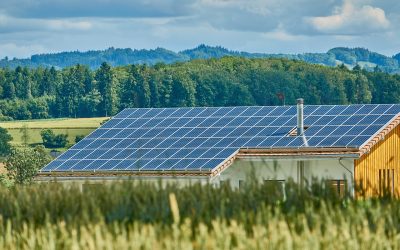Imagine a world where power outages are a thing of the past. A world where you can confidently rely on a steady supply of electricity, without the fear of your appliances suddenly shutting down or living in darkness for hours on end. Thanks to a breakthrough in energy management technology, this once distant dream may soon become a reality. In this article, we explore how advancements in power grid infrastructure and innovative solutions are paving the way for a reduced likelihood of brownouts, bringing us closer to a future of uninterrupted energy supply.

Factors contributing to brownouts
Power generation capacity
One of the primary factors contributing to brownouts is inadequate power generation capacity. When the demand for electricity exceeds the available supply, power grids can become overloaded, leading to brownouts. Insufficient power generation capacity can occur due to various reasons such as population growth, increased industrial activities, or outdated power plants. To tackle this issue, it is crucial to invest in expanding power generation capacity to meet the growing needs of society.
Transmission infrastructure
Another significant factor that can contribute to brownouts is the state of the transmission infrastructure. Aging transmission lines and insufficient infrastructure can result in power losses during energy transfer, leading to brownouts. Upgrading and maintaining the transmission infrastructure is essential to ensure a reliable and efficient power delivery system. Additionally, improvements in transmission technology can help minimize power losses and increase the overall capacity of the grid.
Distribution network capacity
The capacity of the distribution network is also an important factor in preventing brownouts. The distribution network is responsible for delivering electricity to homes, businesses, and industries. If the distribution network is not equipped to handle increased demand or lacks proper maintenance, it can lead to voltage drops and power outages. Investing in upgrading the distribution network’s capacity and implementing advanced monitoring systems can improve its efficiency and reduce the chances of brownouts.
Advancements in power generation technology
Renewable energy sources
The development and integration of renewable energy sources have significantly contributed to reducing the likelihood of brownouts. Renewable energy technologies, such as solar and wind power, are becoming increasingly popular due to their environmental benefits and availability. Their decentralized nature allows for distributed energy generation, reducing stress on the main power grid. By leveraging renewable energy sources, we can diversify the power generation mix and enhance the overall stability and reliability of the electricity supply.
Improved efficiency of power plants
Advancements in power plant technology have also played a crucial role in reducing the risk of brownouts. Modern power plants are designed to be more efficient, converting a higher percentage of fuel energy into electricity. This increased efficiency reduces waste and optimizes power generation capacity. By upgrading older, less efficient power plants with newer models, we can not only improve energy efficiency but also enhance the overall reliability of the power system.
Distributed energy generation
Distributed energy generation involves generating power closer to the point of consumption, often through small-scale renewable energy systems or combined heat and power (CHP) plants. By reducing reliance on large centralized power plants, distributed energy generation helps mitigate the risk of brownouts. These smaller-scale systems can operate autonomously or in coordination with the main grid, providing localized power and increasing the overall system’s resilience.
Enhancements in transmission infrastructure
Grid modernization
Grid modernization refers to the upgrading and digitization of the electrical grid to improve its efficiency, reliability, and resilience. By replacing aging infrastructure, implementing advanced control systems, and integrating communication technologies, the grid becomes better equipped to handle increased demands and prevent brownouts. Grid modernization also enables better monitoring and control of power flow, reducing the chances of overloads or failures in the transmission system.
Smart grid technology
Smart grid technology plays a vital role in reducing the likelihood of brownouts. By incorporating advanced sensors, communication systems, and real-time data analysis, the smart grid enables real-time monitoring and control, optimizing power flow and reducing energy losses. With the ability to detect faults, reconfigure the grid, and manage power demand more effectively, smart grid technology enhances the overall stability and resilience of the power system, minimizing the occurrence of brownouts.
Increased grid stability
Ensuring grid stability is crucial in preventing brownouts and maintaining a reliable power supply. Grid stability refers to the ability of the electrical grid to maintain a balanced and steady flow of electricity. Factors such as voltage fluctuations, frequency variations, and sudden changes in power demand can destabilize the grid. By implementing measures like reactive power compensation, voltage regulation, and synchronized grid operations, grid stability can be improved, reducing the risk of brownouts.
Investments in distribution networks
Upgrading aging infrastructure
Upgrading aging infrastructure within the distribution networks is essential to minimize the occurrence of brownouts. Over time, distribution systems deteriorate, leading to potential failures and power interruptions. By replacing outdated equipment, repairing faulty components, and improving the overall reliability of the distribution network, the risk of brownouts can be significantly reduced.
Installation of advanced monitoring systems
Installing advanced monitoring systems within the distribution networks allows for real-time monitoring of the system’s health and performance. By continuously monitoring factors such as power consumption, voltage levels, and system load, any deviations from normal operation can be detected promptly. This early detection enables quick action to prevent potential problems and mitigate the risk of brownouts.
Improving load management capabilities
Effective load management is crucial for maintaining a stable power supply and reducing the likelihood of brownouts. Companies can implement load management strategies such as load shedding, where non-essential loads are temporarily disconnected during periods of high demand, to balance the load on the distribution network. By optimizing the distribution of power and proactively managing peak demand, the risk of brownouts can be minimized.

Implementation of demand response programs
Encouraging consumer participation
Demand response programs involve incentivizing consumers to modify their electricity usage during periods of high demand. By providing consumers with information and financial incentives, they can voluntarily adjust their energy consumption patterns to coincide with periods of lower demand. This voluntary reduction in demand helps alleviate stress on the power grid, decreasing the likelihood of brownouts. Encouraging consumer participation in demand response programs is crucial for their effectiveness in preventing power interruptions.
Load shifting strategies
Load shifting strategies involve shifting certain energy-consuming activities to off-peak hours when electricity demand is lower. By strategically scheduling tasks such as laundry, dishwashing, or charging electric vehicles during periods of low demand, the load on the power grid can be better balanced. Load shifting reduces the strain on the grid during peak hours, mitigating the risk of brownouts.
Peak-time pricing incentives
Implementing peak-time pricing incentives can motivate consumers to reduce their electricity usage during high-demand periods. By charging higher prices for electricity during peak hours, consumers are encouraged to shift their energy-consuming activities to off-peak hours. This demand-side management approach helps alleviate stress on the power grid, reduces the chances of brownouts, and promotes energy efficiency.
Development of energy storage solutions
Battery storage systems
Energy storage solutions, such as battery storage systems, play a significant role in reducing the occurrence of brownouts. Battery storage allows excess electricity generated during times of low demand to be stored and released during periods of high demand. By providing additional power reserves, battery storage systems help stabilize the grid, ensure a consistent power supply, and reduce the risk of brownouts.
Pumped hydro storage
Pumped hydro storage is a form of energy storage that uses excess electricity to pump water uphill to a reservoir. When electricity demand is high, the water is released downhill, passing through turbines to generate electricity. Pumped hydro storage systems provide a reliable and flexible method of balancing electricity supply and demand, reducing the likelihood of brownouts.
Flywheel energy storage
Flywheel energy storage utilizes the kinetic energy stored in a spinning flywheel to provide instantaneous power when needed. By rapidly spinning the flywheel during periods of low demand, excess electricity is converted into kinetic energy. When demand increases, the kinetic energy is converted back into electricity. Flywheel energy storage systems offer fast response times, high power output, and can help stabilize the grid, minimizing the risk of brownouts.

Utilization of microgrids and islanding capabilities
Localized power generation and distribution
Microgrids are small-scale power systems that can operate independently or in coordination with the main power grid. By utilizing localized power generation sources, such as solar panels or small wind turbines, microgrids provide reliable electricity to a specific area or community. In the event of a power outage or brownout on the main grid, microgrids with islanding capabilities can continue to supply power, ensuring uninterrupted electricity supply and reducing dependence on the main grid.
Improved resilience and reliability
Microgrids offer increased resilience and reliability compared to centralized power grids. Since microgrids operate independently or in coordination with the main grid, they are less vulnerable to widespread outages or distribution network failures. By diversifying energy sources and implementing localized power generation, microgrids enhance the overall reliability of the electricity supply and reduce the risk of brownouts.
Reduced reliance on the main grid
By implementing microgrids and islanding capabilities, communities and facilities can reduce their reliance on the main power grid. This reduced dependence not only ensures an uninterrupted power supply during brownouts or grid failures but also reduces strain on the main grid. By distributing power generation and increasing self-sufficiency, the risk of brownouts can be significantly mitigated.
Effective load forecasting and management
Accurate prediction of power demand
Accurate load forecasting is crucial for preventing brownouts and efficiently managing power supply. By analyzing historical data, taking into account seasonal variations, and considering factors such as weather and economic conditions, power system operators can forecast future electricity demand. This enables them to optimize power generation and distribution, ensuring a reliable and uninterrupted power supply.
Optimizing generation and distribution
Effective load management involves optimizing power generation and distribution to match fluctuations in electricity demand. By using load forecasting data, power companies can adjust their generation schedules, ensuring that there is sufficient electricity supply to meet the projected demand. Additionally, optimizing the distribution infrastructure based on load demand patterns can help prevent overloads and minimize the risk of brownouts.
Minimizing wastage
Efficient load management aims to minimize wastage of electricity by ensuring that generation and distribution capacities are aligned with actual demand. By avoiding excessive generation when demand is low and minimizing transmission losses, power companies can reduce overall energy wastage. This optimization helps maximize the utilization of available resources, reduces strain on the power grid, and reduces the likelihood of brownouts.
Increased awareness and education
Energy conservation practices
Increasing awareness about energy conservation practices can contribute to reducing the likelihood of brownouts. By educating consumers about the importance of minimizing energy consumption, promoting efficient appliance usage, and implementing energy-saving practices, the overall demand for electricity can be reduced. This reduced demand helps alleviate stress on the power grid and reduces the occurrence of brownouts.
Efficient appliance usage
Using appliances efficiently is vital for ensuring the stability of the power grid. Encouraging consumers to choose energy-efficient appliances, avoid unnecessary energy usage, and adopt energy-saving features can make a significant difference. By using appliances properly and responsibly, consumers can help reduce the demand for electricity during peak hours, decreasing the risk of brownouts.
Importance of grid stability
Raising awareness about the importance of grid stability is essential for preventing brownouts. By educating consumers about the potential consequences of power interruptions, the importance of maintaining a stable power grid, and the efforts being made to enhance reliability, individuals can become more conscious of their electricity usage. This increased awareness fosters a sense of responsibility in maintaining grid stability and contributes to a reduced likelihood of brownouts.
Collaboration between stakeholders
Government agencies
Collaboration between government agencies and relevant stakeholders is crucial for reducing the risk of brownouts. Government agencies play a vital role in establishing regulations, setting standards, and providing incentives for investments in power generation, transmission, and distribution infrastructure. By working closely with power companies and consumers, government agencies can create an environment that encourages the implementation of measures aimed at preventing brownouts.
Power companies
Power companies have a responsibility to ensure a reliable and uninterrupted electricity supply to their consumers. By investing in the expansion and modernization of their infrastructure, optimizing load management strategies, and adopting renewable energy sources, power companies can contribute to reducing the likelihood of brownouts. Collaboration between power companies is also essential for sharing best practices, coordinating power supply during emergencies, and maintaining the overall stability of the power grid.
Consumers and community participation
Active participation from consumers and local communities is crucial for preventing brownouts. By adopting energy-saving practices, participating in demand response programs, and utilizing distributed energy generation, consumers can help reduce the strain on the power grid. Engaging in community initiatives, such as microgrid projects or energy conservation programs, allows consumers to actively contribute to a more reliable and stable electricity supply.
In conclusion, various factors contribute to the occurrence of brownouts, including inadequate power generation capacity, transmission infrastructure issues, and insufficient distribution network capacity. However, advancements in power generation technology, such as renewable energy sources and improved efficiency, along with enhancements in transmission infrastructure like grid modernization and smart grid technology, have significantly reduced the likelihood of brownouts. Investments in distribution networks, implementation of demand response programs, development of energy storage solutions, utilization of microgrids, effective load forecasting and management, increased awareness and education, and collaboration between stakeholders also play crucial roles in preventing brownouts. By addressing these factors and implementing appropriate measures, we can ensure a more reliable and resilient electricity supply, minimizing the occurrence of brownouts and providing uninterrupted power to meet the growing needs of society.










